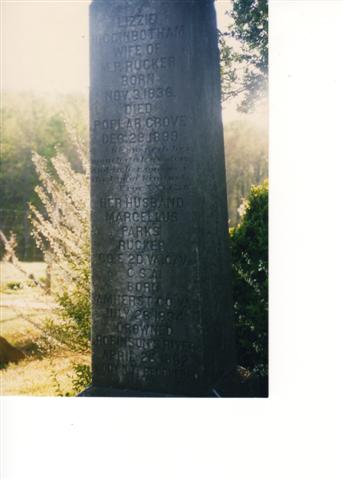A Biographical Sketch of Marcellus Parks Rucker
"Dulce et decorum est pro patria mori”
Marcellus, nicknamed "Paul", and "Lizzie" settled in and began planning a family, but war intervened. He waited to see if the rest of Virginia shared his secessionist sentiments, and enlisted the day the vote was in, May 23, 1861. His choice was the local company of cavalry, the "Amherst Rangers". He rode off to muster in at Lynchburg, where his horse was valued at $125 and the rest of his equipment at $25. He was likely carrying a double-barreled shotgun and perhaps a pistol. By May 24, Captain Thomas Whitehead had received only 24 muskets and three sabers from the state, but had $2200 from the county with which to better equip his troops. Marcellus enlisted as a private for one year, the expectation on both sides being that it would be a short war.
From the Battle of Manassas through the winter of 1861- 62, Marcellus rode with his Amherst cousins. They were reorganized in the Spring of 1862 as Co. E., 2nd Virginia Cavalry, CSA. He reenlisted when the Confederacy realized that the war would be a prolonged one, and began drafting men to fill the thinning ranks. Most of his comrades also reenlisted, both out of patriotic sentiment and for a chance at a furlough and $50 bonus. Beginning a thirty-six day furlough on 2/11/62, Marcellus certainly went home to Amherst to be with his family, which included his new child, Minnie Claude
March 19 would have been the day that the new father returned to his unit; he left a warm home and new baby for the rigors of battle in the cold, Virginia spring. The 2nd Virginia was performing scouting and vidette duties in April, contesting the foraging and scouting parties of the Union cavalry arranged to their north. Destroying stores, and bridges over rain-swollen rivers to slow an anticipated Union advance, the Confederates arrayed over a large portion of Northern Virginia. On April 14, a Union advance forced Marcellus and his company across the Swift Robinson River, between Culpeper and Orange Courthouse. Swimming his horse through the current, he and his mount foundered despite the efforts of his distant cousin, Isaac Henry Rucker, and Marcellus drowned. He was one of three members of the 2nd Virginia to die of drowning during the war.
Lizzie and his baby received scant compensation for the loss of their hero: on 12/29/63 she was paid for her husband's last 104 days of service, an amount totaling $108.20. Of this, his salary constituted $12 monthly, $25 was repayment for clothing that Marcellus bought to supplement the government's meager supply, and $41.60 was for the use and risk of the horse he had brought from home. The mathematically adept will note that both horse and man were paid $.40 a day to defend their country. The memorial marker to Marcellus in the Higginbotham family cemetery at "Poplar Grove" on Old Stage Road in Amherst lists his death date as 4/26/62. If so, the Confederacy shortchanged Lizzie by $9.60.
Daughter Minnie Claude would eventually marry. Interestingly, when Nathan Dawson wrote his will 10/30/82, he included a grand daughter named Mary Marcellus Rucker, even though Marcellus had apparently been his only child living to maturity, and Minnie Claude, Marcellus' only offspring. Did Nathan, still grieving for a lost son, consciously or otherwise rename Minnie Claude? The family line seems to end here, with no descendents to answer the question. For her part, Minnie Claude was still so-named on her marriage certificate, 20 years after Nathan mentioned Mary Marcellus. Perhaps Marcellus' 10-year-old sister in the 1850 census survived to adulthood, and named a daughter Mary Marcellus to honor her mother and brother. If so, Nathan fails to include Minnie Claude in the division of his estate
Compiled by Christopher D. Rucker, M.D., August 17, 1998.
